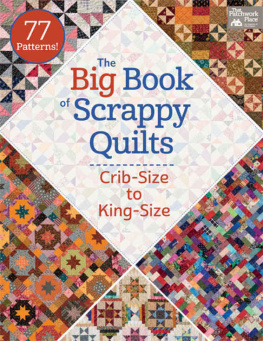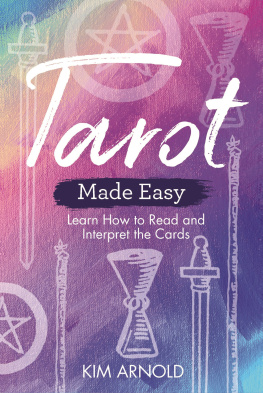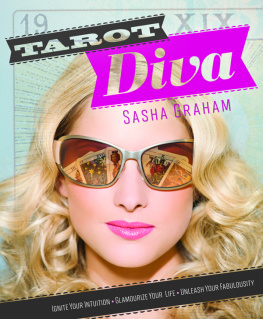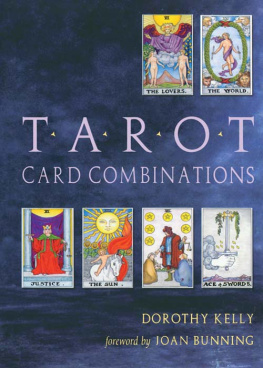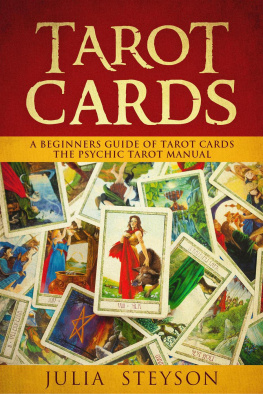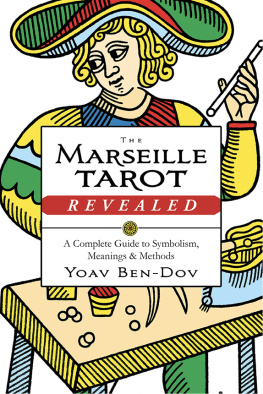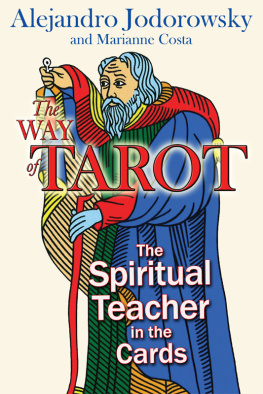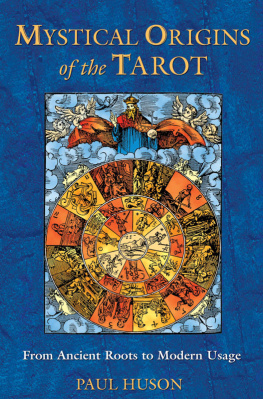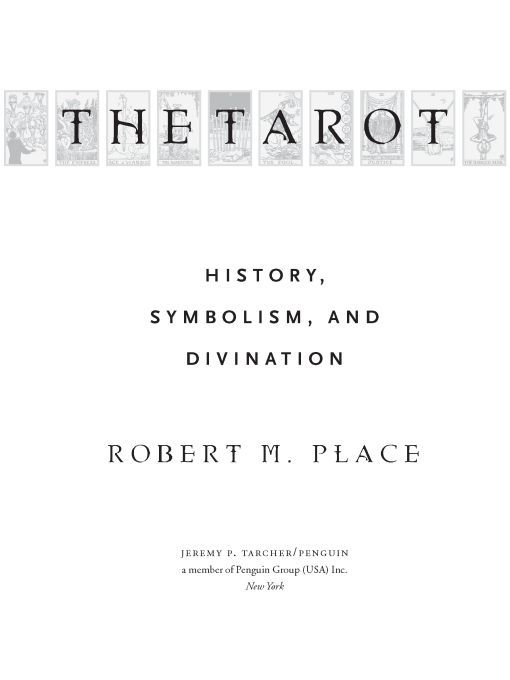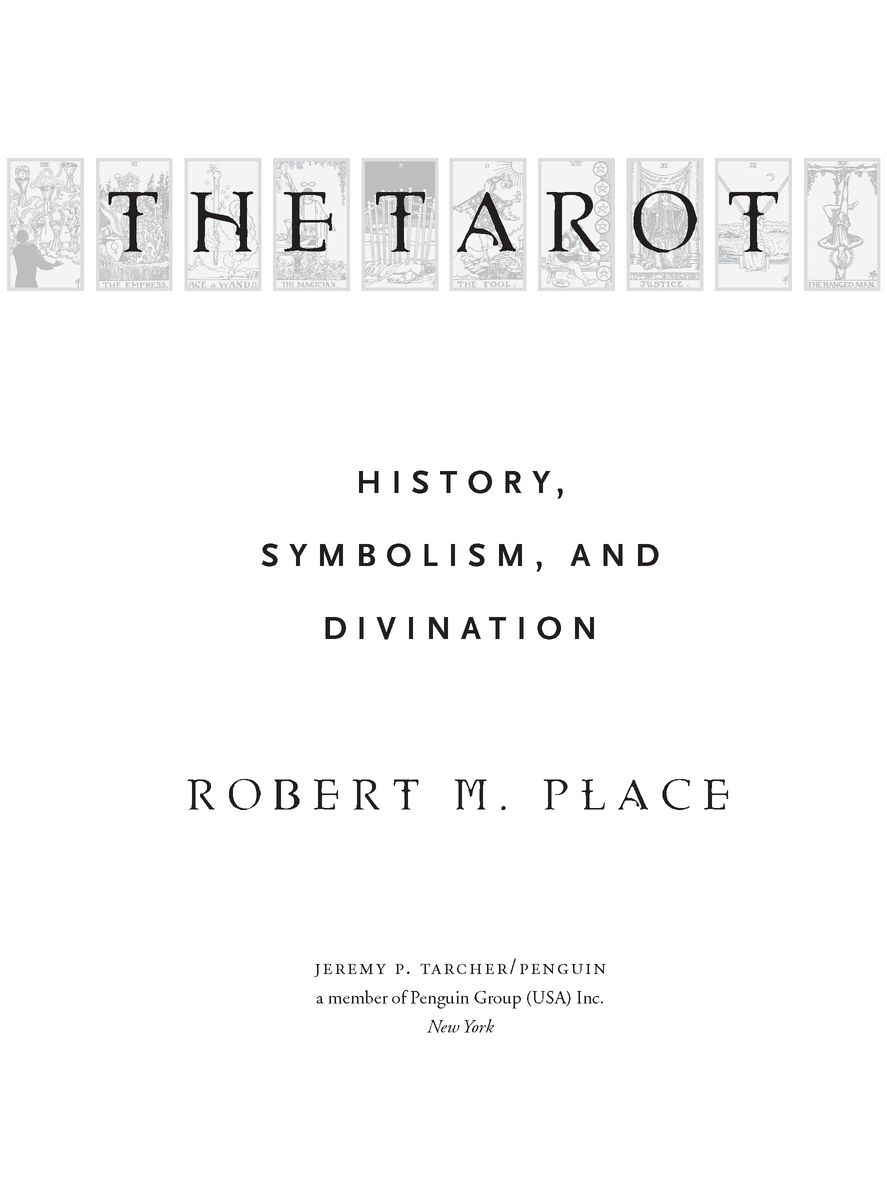Table of Contents
THIS BOOK IS DEDICATED TO CORMAC AND TADHG.
ACKNOWLEDGMENTS
I wish to thank my editor, Mitch Horowitz, for his enthusiasm and encouragement on this project. I want to thank historian Ronald Decker for his assistance and for answering my inquiries, and historians Michael Dummett, Robert ONeill, and Tom Tadfor Little for also answering my inquiries and providing leads. I want to thank William M. Voelkle for making a copy of de Gbelins text for me. I wish to thank Grazia Mirti for providing me with a copy of Fantis Triompho di Fortuna. I also want to thank my wife, Rose Ann, for her encouragement and assistance. And thank you to Arthur Edward Waite for sending me the Tarot in a dream.
INTRODUCTION
It will be thought that I am acting strangely
in concerning myself at this day with what appears at first sight
and simply a well-known method of fortune-telling.
A. E. WAITE, FROM HIS PREFACE TO THE PICTORIAL KEY
TO THE TAROT, 1910
I have been interested in the Tarot and other esoteric subjects since I was studying art in the late 1960s. My girlfriend at that time read the cards. She used the deck that was then called the Rider Waite deck but is now commonly referred to by Tarot scholars as the Waite-Smith deck. With its colorful archetypal images, this early twentieth-century deck is what will come to mind for most people when they think of Tarot.
At that time, I even began to create my own hand-drawn deck based on the Tarot of Marseilles, the traditional French deck that developed in the seventeenth century, but I finished only four cards before I lost interest in the project. Although as an artist I have always been involved in symbolism in my work, I was not directly engaged with the Tarot for many years after that.
When I did become reacquainted with the Tarot, I did not actually choose so in a conscious way. It started with a dream in the summer of 1982, a dream that startled me with its clarity and intensity. I was dreaming that I was following someone through a red brick building. Then I dreamed that a phone rang, interrupting the events of the first dream in the same way that a phone call can interrupt ones thoughts during the day. The sound of the phone startled me into lucidity and intensified the events in the dream in a way that made them impossible to forget. I remember thinking, How can someone call you in a dream? I didnt know that could happen. Even in the dream it was clear that this message came from a place distant from my normal consciousness. The phone was the perfect symbol for this. I picked up the dream phone and on the other end I found an international operator, who informed me that she had a person-to-person call for me from a law firm in England. I accepted the call, and a secretary from the firm came on the line. She told me that she was sending me my ancestral inheritance. She could not tell me what it was, but only that it would come from England, it is kept in a box, and that it is sometimes called the key. She added that I would know it when I saw it. Then she ended the conversation with some precautions: this gift contained a hidden power, but before I could receive this gift, I had to accept the responsibility that came with it. I accepted without hesitation.
I awoke that morning naively expecting to find the box at the foot of my bed; but, of course, there was nothing there. As the week progressed, I eagerly anticipated receiving my inheritance. In a few days, a friend came over with his new deck of Tarot cards. It was the Waite-Smith deck, the deck designed in England in 1909 by Pamela Colman Smith with the direction of Arthur Edward Waite, and it came with a book authored by Waite called The Pictorial Key to the Tarot. As my friend walked through the door, I felt my head turn in his direction as if of its own accord. My eyes also seemed to be working on their own. As they focused on what he was holding, I knew that this was my inheritance. This was not, of course, the first time that I had seen this deck, but I now saw it in a new light. After my friend left, taking his Tarot with him, I made up my mind that I would obtain a Tarot of my own.
In a few more days another friend came to visit and gave me the traditional French deck, The Tarot of Marseilles. This is the deck that evolved in southern France in the seventeenth century and came to this final form in the eighteenth century. It was the one that first drew the attention of the eighteenth- and nineteenth-century occultists, and because of that it has come to be considered the standard deck. My friend said that he just had a feeling that I needed a Tarot deck and he had an old copy of the Marseilles deck hanging around. This was the first deck that I owned, but the Waite-Smith deck remained on my mind, and soon I made a trip from the New Jersey suburbs, where I lived, into Manhattan to buy a copy.
Over the next month, I began experimenting with the cards. At first, I resolved not to read any books on the Tarot since most books that were available then on the Tarot passed on spurious histories and misinformation that stemmed from the occult fantasies of the nineteenth century. I wanted to communicate directly with the images unhindered by these preconceptions. My girlfriend had shown me the so-called Celtic cross spread in college, which involved laying out seven cards in an equal-arm cross and another four in a column to the side for further commentary. So I decided to begin with that approach combined with Jungian techniques of dream interpretation.
As I worked with the Waite-Smith cards, the images spoke to me with amazing clarity. Over the next few months, I began developing new techniques for reading, designed to clarify the communication. From the images alone, I was able to glean philosophical messages that related to my questions. The answers opened up new questions and I began to search for the best books that I could find on the Tarot, Neoplatonism, Gnosticism, alchemy, Renaissance art, ancient and Renaissance philosophy, and related subjects.
The Tarot was like a door that opened onto the Western mystical tradition. I wanted to discover who devised this series of images. I wanted to know the artists who created this deck and to understand what its original creators and users were thinking. Every table in my studio was soon covered with stacks of books reaching toward the ceiling, and I filled a large hardbound notebook with charts, lists, and notes. I was on my way to becoming a Tarot scholar and my primary guide was the Tarot itself.
Since then, I have written four books on the Tarot and created four modern decks. Each book was intended to accompany one of my decks, exploring its particular theme and relationship to Tarot tradition. This, my fifth book, is not about one of my decks. It is about the Tarot in general and how it can be ones companion on the mystical quest. Here I will focus on the imagery in the Waite-Smith deck but I will also delve into the history that lies behind these images and will share my insights on how to use the Tarot for divination.
Occultists, from the eighteenth century on, have recognized that the Tarot illustrates a mystical philosophy. To explain this, they have often resorted to creating a fanciful and exotic origin for the deck. The most popular choice has been ancient Egypt but others have suggested Morocco or even China. Occultists have also invented systems that connect the Tarot to systems such as the Kabalah, the Hebrew alphabet, and astrology. Often their misconceptions lead one away from a true understanding of the actual imagery that is in the Tarot. Historians, meanwhile, have been able to correct these factual errors but have offered little that would help one to understand the Tarots symbolism. Some historians have gone as far as denying that the images in the Tarot have one unified message. To understand what is in the Tarot, I feel that it is essential to examine its historic origin in the Italian Renaissance, to study the iconography and symbolism of that era, and to explore the relationship of that art to the ancient mystical philosophy that was revered by Renaissance artists and writers. This method helps ground ones understanding of the Tarot in the history of its actual development, while connecting to the mystical philosophy and symbolism that underscore the decks synchronous uses. This has been my approach in this book.


